Panasonic’s VT50 series of 3D plasma TVs has received numerous awards from various publications – including technical ones like HDTVTest – since launch in March this year, and deservedly so due to its class-leading blacks, contrast performance and colour accuracy. However, over the past few months an increasing number of owners have reported a discrepancy in black levels between the more accurate out-of-the-box but less configurable [THX Cinema] mode and the more calibration-friendly [Professional] modes. While the Panasonic 50VT50 that we tested back in April 2012 did not exhibit this issue, we’re curious to see if its 55-inch brother – the TX-P55VT50 which we’re reviewing today – is affected.
<!-- google_ad_client = 'pub-2887677957235196'; google_ad_slot = '4990177225'; google_ad_width = 336; google_ad_height = 280; //-->
Note: The specific unit we reviewed was the Panasonic TX-P55VT50B which is the 3-pin-plug British model. Its design, user menu, remote controls, connections, video processing and smart TV functions are the same as those found on the TX-P50VT50 we tested a few months ago, and so won’t be covered in this article.
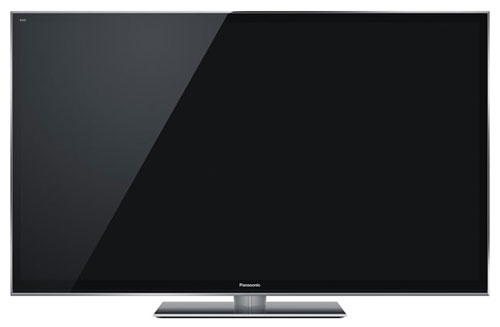
Even before laying a probe on the 55VT50, our eyes could pick up a lightening of blacks when switching from [THX Cinema] to [Professional1] or [Professional2] modes. To be fair, we were conscious of this phenomenon, and was watching the TV in a dimly-lit viewing environment – it may not be apparent to viewers who are not specifically on the lookout, or use the set in a brighter room.
Running some measurements on the TXP55VT50 with our Klein K-10 meter confirmed our subjective observations. In [THX Cinema] mode, black level came in at 0.009 cd/m2, which is consistent with the minimum luminance levels (MLLs) measured on this year’s Panasonic plasmas. In the [Professional] modes however, the figure almost doubled to 0.017 cd/m2. Because of the way the human eye responds to light, this doesn’t mean that the perceived black in [Professional] mode is twice as bad as that in [THX Cinema] mode, but there is still a visible difference in an environment we typically use for critical viewing.
As with the 42GT50 on which this issue was also present, we gave priority to contrast performance over greyscale accuracy, and went with the [THX Cinema] mode – even though it’s missing white balance and colour management controls – for 2D viewing.
![RGB tracking in [THX Cinema] mode](https://www.hdtvtest.co.uk/news/wp-content/uploads/2018/04/hdtv_Panasonic-TXP55VT50_rgb.png) |
| RGB tracking and delta errors (dEs) in [THX Cinema] mode |
This is pretty good for an out-of-the-box picture preset – dEs were less than 4 for the crucial midsection of luminance intervals from 40% to 90% stimulus. We could improved this even further to near-perfection in the [Professional] modes which are equipped with fully functional calibration controls, but then we would have to put up with worse black-level performance.
Gamma on the Panasonic TX-P55VT50B in [THX Cinema] mode averaged around 2.2, which given the lack of gamma control in this picture preset means that we were unable to adjust it closer to the 2.4 target – established by ITU as the reference electro-optical transfer function (EOTF) for flat-screen HDTVs used in studio mastering – we now shoot for.
![Gamma in [THX Cinema] mode](https://www.hdtvtest.co.uk/news/wp-content/uploads/2018/04/hdtv_Panasonic-TXP55VT50_gamma.png) | |
| Gamma in [THX Cinema] mode | Corresponding gamma tracking |
Measuring gamma on a plasma display panel (PDP) can be tricky depending on the size of the windowed pattern used, and how aggressive the ABL (automatic brightness limiting) implemented is. This is reflected by the dip near the top-end of the luminance range.
Again, with no colour management system (CMS) available in the [THX Cinema] preset, we were largely stuck with what we had. Fortunately, there were no glaring inaccuracies in terms of chromaticities, which is remarkable for a built-in picture mode (i.e. no additional adjustments necessary on the part of the user). The colour saturation tracking – over which we wouldn’t have control anyway even with the help of a CMS, because no HDTV on the market features inbuilt multi-point colour adjustments at press time – was particularly impressive… certainly one of the best we’ve seen since we started measuring this parameter with the advent of Calman 5.
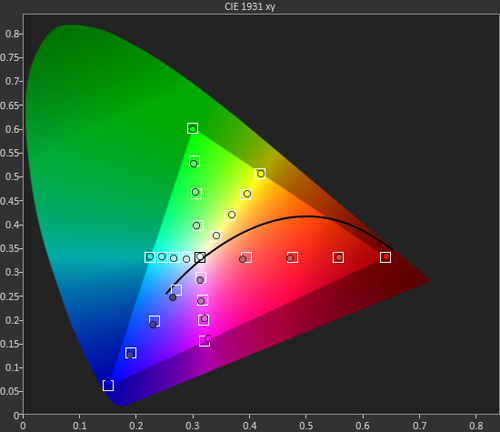 |
| CIE chart with colour saturation tracking in [THX Cinema] mode |
As far as colour brightness was concerned, it was up and down across the six primary and secondary colours relative to the target luminance. Using the main [Colour] control, we prioritised colour decoding for red (and to a lesser extent blue), making sure there was no red push.
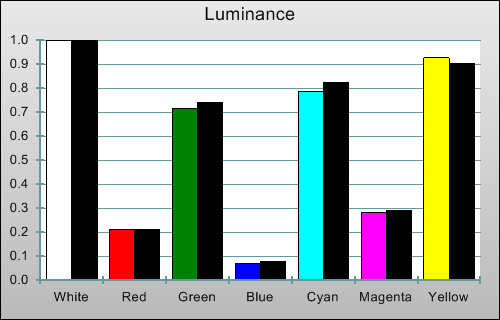 |
| Colour luminance (coloured bars = targets; black bars = measured values) |
We had no qualms using the [Professional] modes on the Panasonic TX-P55VT50 for tri-dimensional material – minimum luminance level (MLL) is less of a concern in the third dimension due to the darkening effect of active-shutter glasses. So we attached the included Panasonic TY-ER3D4MA 3D eyewear to the front of our Klein K-10 meter, and calibrated away.
For those who are not going to calibrate the TXP55VT50B in 3-D (probably the vast majority of users), [THX3D Cinema] mode is still the ticket to obtaining an image that comes closest to broadcast and video industry standard. Any greyscale measurement is likely going to differ wildly from one set to another though, not least due to the tint imparted by the 3D eyewear. On our review sample (as analysed through one of the two pairs of supplied active-shutter glasses), the low end was overtly blue, whereas there existed a red cast from 30% stimulus on:
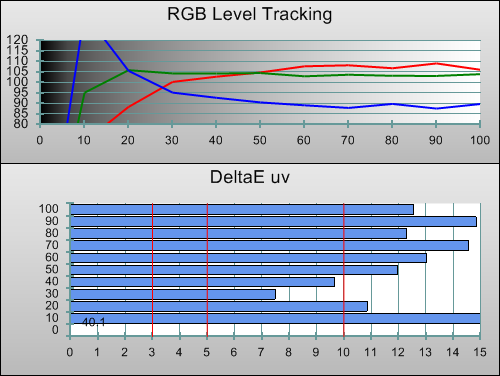 |
| 3D pre-calibration RGB tracking and delta errors (dEs) in [THX3D Cinema] mode |
This is where the full array of calibration controls in the [Professional] modes came in handy. Like a jailbreak team that has gotten hold of a newly released iPhone, we gleefully tweaked the 10-point [White Balance] controls to calibrate the TX-P55VT50B’s greyscale in 3D display mode:
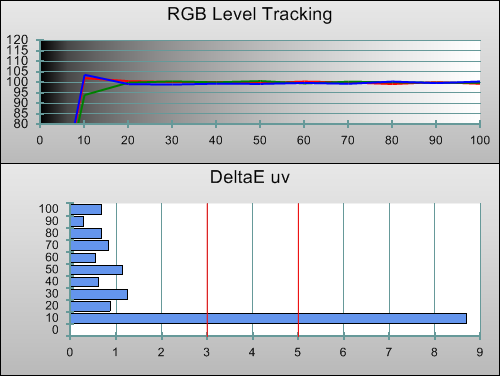 |
| 3D post-calibration RGB tracking and delta errors (dEs) in [Professional1] mode |
The result was nothing less than stunning, serving as a solemn reminder of the kind of reference greyscale performance that could be achieved in 2D mode had Panasonic not brashly crippled the [Professional] modes with less-than-reference blacks.
Panasonic’s [Colour Management] system is probably the most intuitive and functional one among the major TV brands at present, allowing us to finetune all three aspects (hue, saturation, brightness) of all six primary and secondary colours on the TXP55VT50:
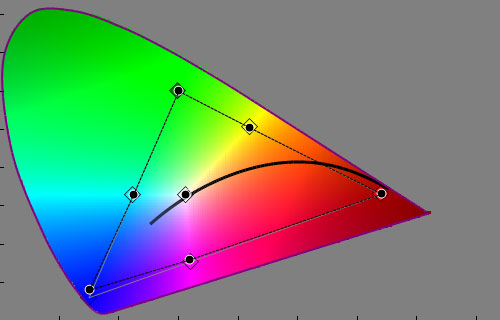 |
| 3D post-calibration CIE chart in [Professional1] mode |
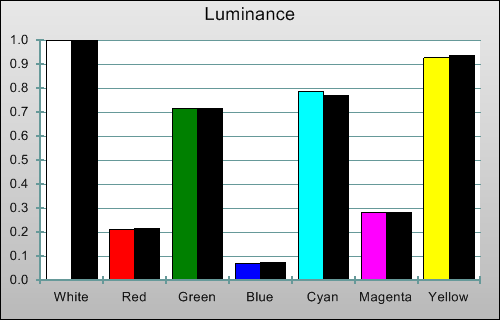 |
| 3D colour luminance (coloured bars = targets; black bars = measured values) |
Blue primary couldn’t be fully saturated (almost certainly owing to the constraints imposed by the 3D eyewear), and cyan was slightly deficient luminance-wise, but these shouldn’t be noticeable to most people in real-world viewing outside of side-by-side comparison with a reference display.
| Dead pixels | None |
| Screen uniformity | Thin stripe of lighter discolouration on right side of screen |
| Overscanning on HDMI | 0% with [16:9 Overscan] set to “Off“ |
| Blacker than black | Passed |
| Calibrated black level (black screen) | 0.009 cd/m2 [THX Cinema]; 0.017 cd/m2 [Professional] |
| Calibrated black level (ANSI checkerboard) | 0.012 cd/m2 [THX Cinema]; 0.019 cd/m2 [Professional] |
| Black level retention | Stable |
| Primary chromaticity | Very good |
| Scaling | Excellent |
| Video mode deinterlacing | Very effective jaggies reduction |
| Film mode deinterlacing | Passed 3:2 cadence in 480i and 1080i, and 2:2 in 576i |
| Viewing angle | Excellent |
| Motion resolution | Excellent (1080 natively) |
| Digital noise reduction | Acceptable at baseline |
| Sharpness | “Clover leafing” on luma zone plate pattern; not visible in real-life content |
| Image retention | A few instances, which are quickly cleared |
| Posterization | Mild, though worse with poor source and fast motion |
| Phosphor trails | Mild, though severity depends on individual susceptibility |
| 1080p/24 capability | Judder-free in 2D and 3D |
| Input lag | 28ms compared to lag-free CRT |
| Default [Normal] mode (2D) | 217 watts |
| [THX Cinema] mode (2D) | 186 watts |
| Default [Normal] mode (3D) | 262 watts |
| Calibrated [Professional1] mode (3D) | 233 watts |
| Standby | <1 watt |
Note: Measurements taken with full-field 50% grey screen to approximate real-world viewing.
Even though we’ve seen a number of Panasonic plasma televisions this year, we never get tired of watching HD broadcast or Blu-ray content on yet another one, thanks to the outstanding picture quality on show. The TX-P55VT50B’s larger screen size (well, relative to the 40- and 50-inchers that we’re more used to reviewing) delivered a wonderfully immersive viewing experience, inviting our eyes to drink in the sumptuous images – underpinned by inky blacks, rich yet realistic colours, as well as blur-free motion – displayed on screen.

Talking about motion though, the Panasonic 55VT50 evinced some dynamic false contouring, particularly on sources with lower bitrates. A trait commonly seen on plasma TVs, this refers to the breaking up of what should be a smooth gradient on moving objects into distinct “steps” (also known as posterization or banding). While the ones exhibited by Panasonic’s plasmas are more noticeable due to their tendency to introduce aberrant colours into the posterized areas, we don’t think it is a deal-breaker in light of the sets’ other strengths.
Football season is back in full swing, affording us the opportunity to check out the infamous “double fuzzy image” issue usually seen on 50Hz material. While still present to a minor extent on the TX-P55VT50, it was not intolerable, and certainly less obvious compared to 2010 models. Engaging [Intelligent Frame Creation] would clear this up even more, but introduce a few motion interpolation artefacts (the ball would tear up slightly when it went past the crowd from a goal kick, for example) even on the “Min” setting.
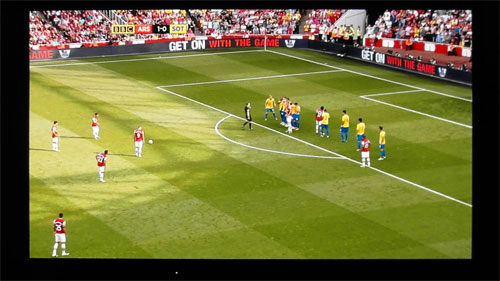
Perhaps as a result of the Japanese firm’s involvement in Blu-ray authoring and encoding through its Panasonic Hollywood Laboratory (PHL) arm, its flat-panel HDTVs in recent years have handled 1080p/24 signal flawlessly, and the TX-P55VT50B continues this fine tradition. In fact, the plasma TV didn’t skip a beat in presenting any sort of content we threw at it – be it 50Hz, 60Hz or 24p, in 2D or 3D – without so much of a hint of judder.
Let’s get one thing straight: the Panasonic TX-P55VT50 is a superb HDTV display, particularly for owners who do not intend to perform advanced calibration on the plasma TV either themselves or with help from a professional. Its out-of-the-box picture quality – with [THX Cinema] mode engaged – is pretty much unrivalled on the consumer market at this time of writing, thanks in no small part to class-leading black-level and contrast performance, as well as sufficiently accurate greyscale and colours.
However, we have one complaint about the TX-P55VT50B, and it’s not an insignificant one given that our reviews are aimed at the video enthusiast audience who care about squeezing the last drop of image fidelity from their TVs. The measured black level in the [Professional] modes – the most calibration-friendly picture presets that can let us improve greyscale and colours to near-perfection – is nearly twice as high as that in [THX Cinema] mode which lacks the more advanced picture-affecting controls.
Although this does not mean that the perceived black is twice as bad in the [Professional] modes due to a combination of the luminosity response curve of the human eye, and the fact that most real-world content contain brighter areas which distract us from lighter blacks, there is still a visible difference in a dimly-lit viewing environment which film enthusiasts typically adopt for critical viewing. Users who calibrate their televisions are the very ones who are most likely to pay particular attention to the black level: it simply doesn’t make sense for them to have to sacrifice one for the other, on a flagship display no less.
As it turned out, maximum brightness was also lower in the [Professional] modes (79 cd/m2) compared to [THX Cinema] (100 cd/m2), making the former less suitable for use during the daytime. What this means is that the step-down ST50 series may be a more attractive proposition for the tweakers and tinkerers out there: it has no such limitations imposed on both ends of the luminance range across all its presets, perversely delivering higher contrast ratio than the VT50 in their respective most adjustable picture modes (even though the ST50 only offers 2-point instead of 10-point white balance). Nevertheless, for those who just want the best possible picture out of the box without fuss, no other flat-screen television on the market is a match for the Panasonic VT50.
